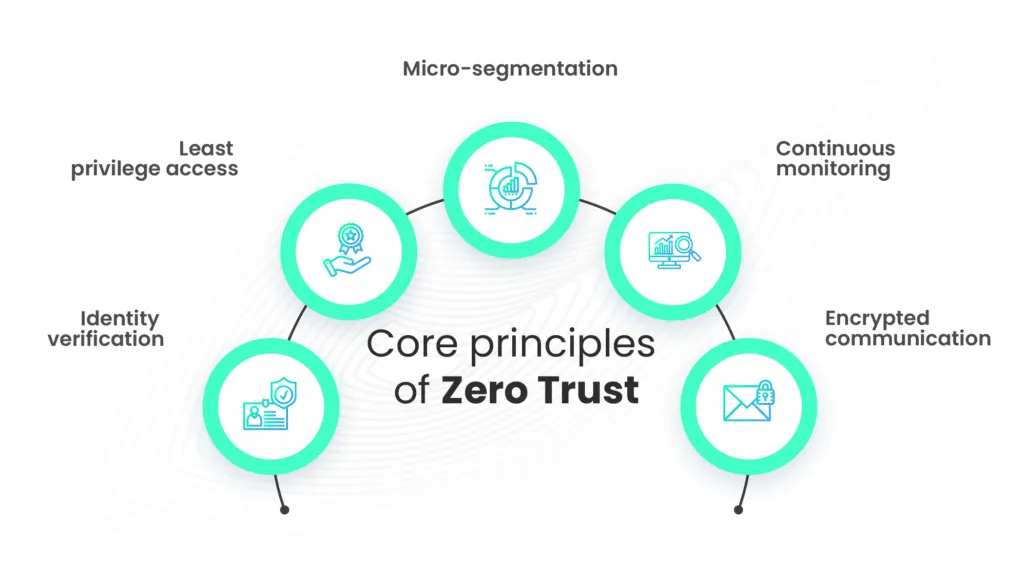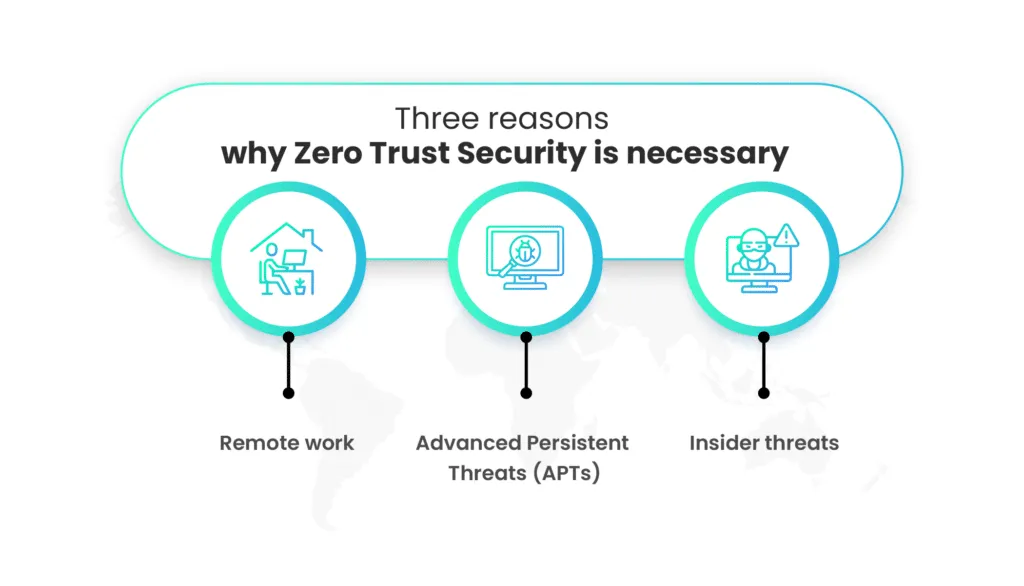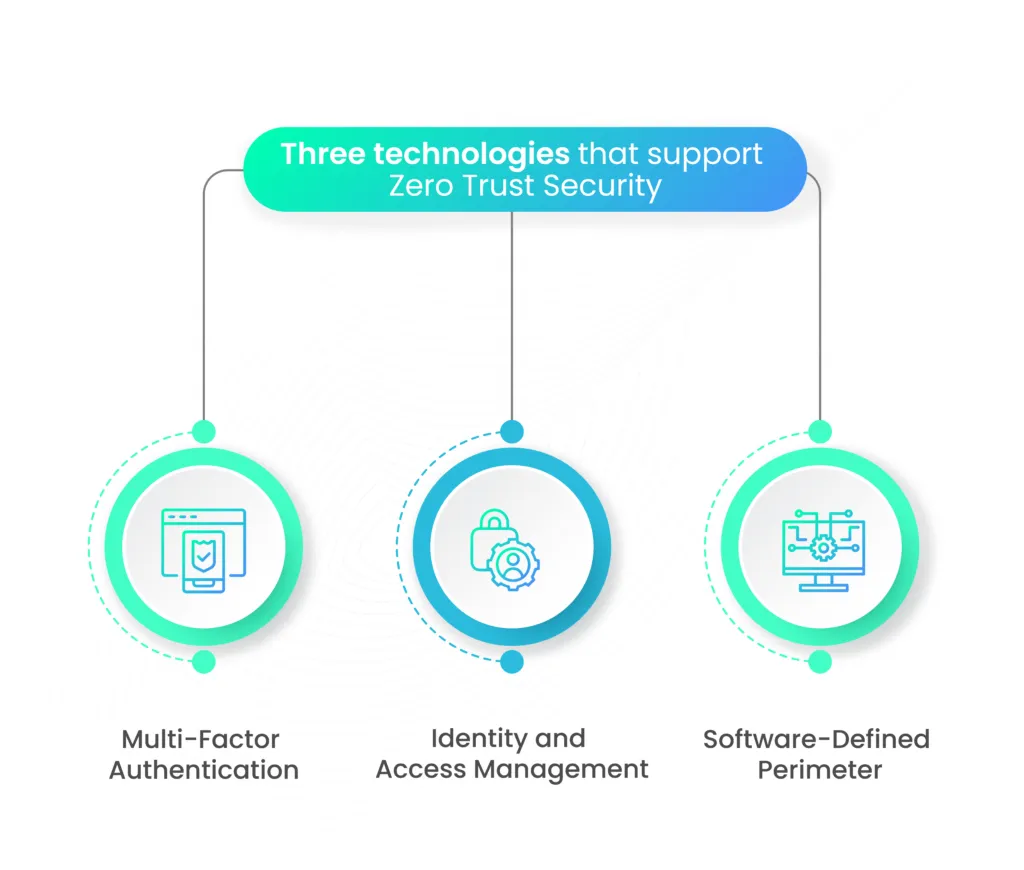Embracing Zero Trust Security: A definitive guide

In an interconnected world where boundaries blur, and the digital landscape stretches far and wide, traditional security models find themselves outpaced by the relentless evolution of cyber threats.
Enter the era of Zero Trust Security — a paradigm shift that challenges the age-old assumption that trust should be granted based on network location. It’s time to reframe our approach to cybersecurity and adopt a mindset that places skepticism at its core.
The Zero Trust Model challenges the traditional castle-and-moat mentality, ushering in an era of continuous verification, dynamic access controls, and heightened cybersecurity awareness.
This blog aims to unravel the complexities of Zero Trust Security, shedding light on its principles, methodologies, and the transformative impact it can have on an organization’s cybersecurity posture.
What is Zero Trust?
Zero Trust is a cybersecurity concept and model that challenges the traditional security approach, which typically relies on the assumption that entities within a network can be trusted by default. In contrast, Zero Trust operates on the principle of “never trust, always verify.” The core tenet is to eliminate the notion of implicit trust based on a user’s location (inside or outside the corporate network) and instead requires continuous verification of identity and strict access controls.
In a Zero Trust Security model, trust is never assumed, and all users, devices, applications, and network components are treated as potentially untrusted, regardless of their location or previous access history. This approach recognizes that threats can come from both external and internal sources, and it seeks to minimize the potential damage that can occur when a network perimeter is breached.
What are the core principles of the Zero Trust Security model?
The Zero Trust Security model is built on several core principles that collectively contribute to its overarching philosophy of “never trust, always verify.” These principles guide organizations in redefining their approach to cybersecurity, emphasizing continuous verification, strict access controls, and adaptive security measures.

The key principles of the Zero Trust Security model include:
Identity verification
All users and devices attempting to access resources must be verified and authenticated.
Multi-factor authentication (MFA) is commonly employed to add an extra layer of identity verification beyond passwords.
Least privilege access
Users and devices are granted the minimum level of access required to perform their tasks.
Access permissions are tailored to specific roles and responsibilities to limit potential damage in case of a security compromise.
Micro-segmentation
Network segmentation is implemented at a granular level to create isolated zones within the network. This limits lateral movement within the network, making it more challenging for attackers to navigate and escalate privileges.
Instead of having a flat network where all devices can communicate freely, micro-segmentation divides the network into isolated segments.
For instance, a finance department’s servers can be segmented from the marketing department’s servers, reducing the risk of lateral movement within the network if one segment is compromised.
Continuous monitoring
Continuous monitoring of users, devices, and network activities is essential.
Anomalies and potential security threats are detected in real-time, allowing for swift response and mitigation.
Adaptive security
The security posture dynamically adapts based on the changing threat landscape and contextual factors. This includes adjusting access controls, permissions, and security measures based on real-time assessments of user behavior, device health, and network conditions.
Breach assumption
Instead of relying on the belief that the network perimeter is impenetrable, Zero Trust assumes that breaches can and will occur. Security measures are designed with the understanding that threats can come from both external and internal sources.
Encrypted communication
Encrypted communication is prioritized to secure data in transit. This ensures that even if network traffic is intercepted, the information remains confidential.
Risk-based decision-making
Decisions regarding access and security measures are based on risk assessments.
Contextual information, such as the user’s location, behavior, and the device’s health, is considered to determine the level of risk.
Why is Zero Trust Security important?
Zero Trust security is crucial in today’s business landscape, marked by global digitization and the dissolution of traditional corporate boundaries. As organizations expand digitally, the challenge of securing a growing array of attack surfaces becomes monumental.
The evolving threat landscape, characterized by sophisticated attackers leveraging automation and cutting-edge technology, has turned cybersecurity into a constant street fight where trust is a luxury no one can afford. Disturbingly, in the first quarter of 2023, over six million data records were exposed globally through data breaches.
Furthermore, regulatory bodies have heightened security expectations, especially regarding customer data.
The zero-trust approach is crucial in today’s complex and evolving threat landscape for the following reasons:
Changing perimeter
Traditional security models rely on the concept of a well-defined network perimeter. However, with the rise of cloud computing, mobile devices, and remote work, the traditional network perimeter has become increasingly porous and difficult to define. Zero Trust acknowledges that the network perimeter is no longer a reliable boundary for security.

Advanced Persistent Threats (APTs)
Cyber adversaries have become more sophisticated, often employing advanced techniques and tools to compromise systems. APTs can remain undetected for long periods, moving laterally within a network. Zero Trust data security helps mitigate the risk of APTs by requiring continuous verification and monitoring of all activities, making it more challenging for attackers to move undetected.
Insider threats
Insider threats, whether malicious or unintentional, pose a significant risk to organizations. Zero Trust recognizes that not all users or devices within the network can be trusted implicitly. It requires continuous monitoring and authentication, even for users with privileged access, reducing the risk of internal threats.
Remote work and Bring Your Own Device (BYOD)
The traditional security model assumes that all users are within the corporate network. However, the modern workforce is increasingly mobile, with employees working from various locations and using personal devices. Zero Trust ensures that regardless of the user’s location or device, proper authentication and authorization are required before accessing sensitive resources.
Microservices and cloud computing
With the adoption of microservices architecture and cloud-based services, applications are distributed across various environments. Zero Trust adapts to this distributed nature, focusing on securing individual components and transactions rather than relying on a centralized perimeter defense.
Data protection and privacy
Regulatory frameworks such as the General Data Protection Regulation (GDPR) in Europe and the California Consumer Privacy Act (CCPA) in the United States emphasize the need for organizations to protect the privacy and confidentiality of personal data. Zero Trust, by focusing on data-centric security and access controls, helps organizations comply with these requirements by reducing the risk of unauthorized access to sensitive information.
Access controls and authentication
Many regulations mandate the implementation of strong access controls and multi-factor authentication to ensure that only authorized individuals can access sensitive data. Zero Trust aligns with these requirements by enforcing the principle of least privilege, requiring continuous authentication, and ensuring that access is granted based on a user’s specific needs and roles.
Continuous monitoring and incident response
Regulations often require organizations to implement continuous monitoring and rapid incident response capabilities. Zero Trust’s emphasis on continuous monitoring of user activities and network behavior aligns with these requirements, enabling organizations to detect and respond to security incidents promptly, which is crucial for compliance.
Auditing and accountability
Compliance frameworks typically require organizations to maintain audit logs and demonstrate accountability for security events. Zero Trust facilitates auditing by providing detailed logs of user activities, access requests, and network transactions. This information is valuable for compliance audits and investigations into security incidents.
Customer trust
Zero Trust’s emphasis on data-centric security ensures that customer data is safeguarded with the highest level of protection. By implementing robust access controls, encryption, and continuous monitoring, organizations can demonstrate a strong commitment to protecting customer privacy. This assurance builds trust among customers, knowing that their sensitive information is handled with the utmost care and security.
Best practices for enforcing Zero Trust Security
Enforcing a Zero Trust Security model involves a set of best practices designed to ensure that trust is never assumed and that security measures are consistently applied across an organization’s network, systems, and data. Here are detailed best practices for enforcing Zero Trust:
Identify and classify assets
Begin by identifying and classifying all assets, including data, applications, and systems. Understanding what needs protection is foundational to implementing zero-trust data security. Categorize assets based on sensitivity and criticality to prioritize security efforts.

Least privilege access
Implement the principle of least privilege, ensuring that users and devices have the minimum level of access necessary to perform their specific tasks. Regularly review and update access permissions based on job roles and responsibilities to limit potential exposure.
Continuous authentication
Adopt continuous authentication mechanisms to verify the identity of users and devices throughout their session. This includes multi-factor authentication (MFA) and adaptive authentication that assesses risk factors in real-time to grant or deny access.
Micro-segmentation
Implement micro-segmentation to divide the network into smaller, isolated segments. This limits lateral movement in case of a breach, making it more difficult for attackers to navigate and access sensitive areas within the network.
Network visibility and monitoring
Enhance network visibility by implementing robust monitoring and logging systems. Continuously monitor network traffic, user activities, and system behavior to detect anomalies or suspicious activities promptly. Real-time monitoring allows for rapid response to potential security incidents.
Encryption of data in transit and at rest
Utilize encryption protocols to protect data both in transit and at rest. This safeguards sensitive information from unauthorized access, even if a breach occurs. Ensure that encryption keys are properly managed and secured.
Device trustworthiness assessment
Evaluate the trustworthiness of devices attempting to access the network. Implement device posture assessments to ensure that only devices with up-to-date security configurations and patches are allowed access.
Application-centric security
Adopt an application-centric security approach. Instead of relying solely on network-level security, focus on securing individual applications. Implement application-layer controls and policies to safeguard critical business applications.
Continuous monitoring and incident response
Establish a robust incident response plan that includes continuous monitoring of security events. Define procedures for identifying, containing, eradicating, recovering from, and analyzing security incidents. Regularly test and update the incident response plan.
User education and awareness
Educate users about security best practices and the principles of Zero Trust. Foster a security-aware culture within the organization, encouraging employees to report suspicious activities and adhere to security policies.
Secure remote access
Given the prevalence of remote work, secure remote access is crucial. Implement secure Virtual Private Network (VPN) solutions, secure web gateways, and ensure that remote users adhere to the same stringent security measures as on-site users.
Regular security audits and assessments
Conduct regular security audits and assessments to evaluate the effectiveness of Zero Trust controls. Identify weaknesses, address vulnerabilities, and continuously improve security measures based on emerging threats and evolving business requirements.
Vendor risk management
Extend Zero Trust principles to third-party vendors and partners. Evaluate the security practices of external entities that have access to your network or data and enforce the same level of security controls as for internal users.
Regular training and skill development
Invest in regular training and skill development for security teams. Keep them updated on the latest threats, technologies, and best practices to ensure they can effectively enforce and adapt Zero Trust security measures.
Technologies that can be used to enforce Zero Trust Security
Enforcing Zero Trust Security requires the implementation of various technologies that can provide robust authentication, authorization, monitoring, and protection mechanisms. Here are key technologies commonly used to enforce Zero Trust Security:

Multi-Factor Authentication (MFA)
MFA is one of the best Zero Trust security solutions. It adds an extra layer of security by requiring users to provide multiple forms of identification before gaining access. This typically involves something the user knows (password), something they have (smart card or token), or something they are (biometrics).
Identity and Access Management (IAM)
IAM solutions help manage user identities and control access to resources based on predefined policies. These systems ensure that users have the right permissions and access levels, aligning with the principle of least privilege.
Software-Defined Perimeter (SDP)
SDP solutions create a dynamic, “software-defined” perimeter around specific resources rather than relying on a traditional network perimeter. This limits visibility and access to authorized users, reducing the attack surface.
Network micro-segmentation
Network micro-segmentation divides the network into smaller, isolated segments, enhancing security by restricting lateral movement. This can be achieved through network virtualization technologies and firewalls that operate at the application or workload level.
Endpoint security solutions
Endpoint security tools, including next-generation antivirus, endpoint detection and response (EDR), and mobile device management (MDM) solutions, are excellent Zero Trust security solutions. They help secure devices (endpoints) that access the network, ensuring they meet security standards.
Zero Trust Network Access (ZTNA)
ZTNA solutions, also known as “perimeterless” network access, provide secure access to applications based on user identity and device trustworthiness. ZTNA replaces traditional VPNs with more granular, context-aware access controls.
Encryption technologies
Encryption is crucial for protecting data both in transit and at rest. Technologies such as Transport Layer Security (TLS) for communication and full-disk encryption for storage ensure that even if data is intercepted, it remains unreadable.
Security Information and Event Management (SIEM)
SIEM solutions collect, analyze, and correlate security event data from various sources within the IT infrastructure. They provide real-time insights into security incidents and support incident response efforts.
Endpoint Detection and Response (EDR)
EDR solutions focus on detecting and responding to advanced threats on endpoints. They provide visibility into endpoint activities, enabling security teams to investigate and respond to security incidents.
Threat intelligence platforms
Threat intelligence platforms collect and analyze data on emerging threats and vulnerabilities. By incorporating threat intelligence into security measures, organizations can proactively defend against known threats.
Compliance software
Compliance software assists risk, compliance, and security officers in continuously auditing internal security measures. It streamlines compliance workflows, making it easier to maintain a secure and compliant information system compared to manual processes.
With the increasing demand for continuous auditing due to strict regulations and customer expectations, compliance operations software automates tasks such as gathering evidence of controls’ effectiveness and assigning remediation tasks. This automation eases the burden on security teams, allowing them to focus on proactively securing networks and mitigating threats.
Real-life examples of Zero Trust success
Zero Trust Security is a journey, and organizations may implement these principles at different paces and in varying ways based on their unique needs and environments. Companies often leverage a combination of technologies, policies, and cultural changes to transition to a zero-trust model successfully.
Here are a few examples of companies that have publicly embraced and discussed their commitment to Zero Trust Security:
Google has been a proponent of Zero Trust Security and has openly shared insights into its implementation. The BeyondCorp model, developed by Google, is a notable example. It shifts the focus from network-based security to user and device-based security, irrespective of the network location.
Cisco
Cisco has been vocal about its adoption of Zero Trust principles. The company emphasizes the importance of continuous verification and segmentation to protect against lateral movement within the network. Cisco’s approach involves implementing a secure access service edge (SASE) architecture to support Zero Trust Security.
Rackspace Technology
Rackspace, a leading managed cloud service provider, has embraced Zero Trust Cloud Security to enhance its cybersecurity measures. The company emphasizes the importance of continuous monitoring, identity-centric security, and network segmentation.
Conclusion
In a world where digital boundaries are blurred and cyber threats evolve relentlessly, embracing the principles of Zero Trust Security becomes imperative.
This paradigm shift challenges traditional security models by replacing implicit trust with continuous verification, dynamic access controls, and heightened cybersecurity awareness.
This blog has navigated through the core tenets of Zero Trust Security, unraveling its complexities and showcasing its transformative impact on an organization’s cybersecurity posture.
As businesses continue to digitize globally, the adoption of Zero Trust is not just a recommendation—it’s a necessity for building customer trust.
Using Scrut’s Trust Vault is another great way to build customer trust. Schedule a demo today to learn more.
FAQs
1. What is Zero Trust?
Zero Trust is a cybersecurity concept and model that challenges the traditional security approach, operating on the principle of “never trust, always verify.” It eliminates the notion of implicit trust based on a user’s location and requires continuous verification of identity and strict access controls.
2. Why is Zero Trust Security important?
Zero Trust is crucial due to the changing perimeter, advanced persistent threats (APTs), insider threats, remote work trends, microservices/cloud adoption, data protection regulations, and the need for robust access controls. It ensures a proactive and adaptive security posture.
3. What are the core principles of Zero Trust Security?
The core principles include identity verification, least privilege access, micro-segmentation, continuous monitoring, adaptive security, breach assumption, encrypted communication, and risk-based decision-making.
4. How can organizations enforce Zero Trust Security?
Enforcing Zero Trust involves identifying assets, implementing least privilege access, continuous authentication, micro-segmentation, network visibility, encryption, device trustworthiness assessment, application-centric security, continuous monitoring, user education, secure remote access, regular audits, vendor risk management, and training.
5. What technologies can be used to enforce Zero Trust Security?
Key technologies include Multi-Factor Authentication (MFA), Identity and Access Management (IAM), Software-Defined Perimeter (SDP), Network Micro-Segmentation, Endpoint Security Solutions, Zero Trust Network Access (ZTNA), Encryption Technologies, Security Information and Event Management (SIEM), Endpoint Detection and Response (EDR), Threat Intelligence Platforms, and Compliance Operations Software.


















